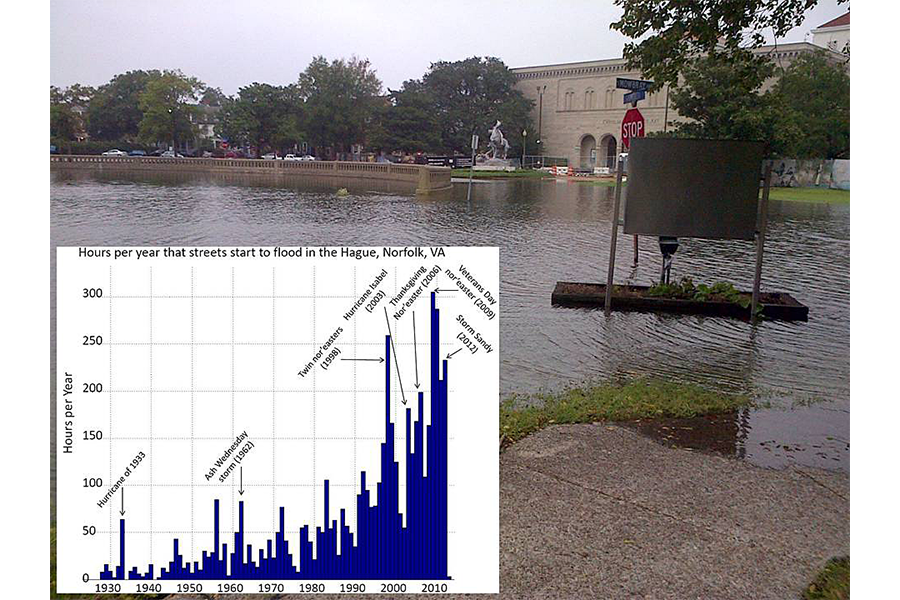What is the Atlantic blob? And should we worry?
Loading...
| Norfolk, Va.
Those preparing for Hurricane Joaquin might want to know that some researchers say a foot has been added on to the usual tidal flooding estimates.
But don't blame Joaquin entirely. The extra tidal boost is coming from the Atlantic ‘blob’ – a body of cold, fresh water that has been puzzling scientists.
Researchers say that the slowing down of the planet’s oceanic circulatory system is being felt particularly along the Atlantic coast of the United States.
The Atlantic ‘blob’ is a patch of unusually cold surface waters in the North Atlantic just south of Greenland. It is not to be confused with the Northern Pacific ‘blob’ of warm waters.
Michael Mann, Pennsylvania State University climate change expert writes in an email that this is likely “a signature of ongoing slowdown of the Atlantic ‘conveyor belt’ circulation.”
A study published in March in the journal Nature by Dr. Mann and his colleagues suggested that the introduction of freshwater from melting Greenland ice into the North Atlantic could be playing a key role in the slowdown.
“The most significant impact, however, might be on the conditions (deep convection of the ocean) that are responsible for the surface nutrients that make the extratropical North Atlantic one of the most productive regions of the world’s oceans,” Mann writes. “That would have negative repercussions for the entire food web, and could severely impact fish populations we rely upon for food.”
For humans this weekend, the most significant impacts are likely to be flooded cars and basements.
Old Dominion University oceanographer Larry P. Atkinson works as part of a global team of scientists taking part in the Climate Change and Sea Level Rise Initiative. “There are things going on up in the North Atlantic – that big climate scale process – as that changes, there are all kinds of other things that happen," he says in an interview. "Like this sea level rise, [the] gulfstream slowdown, and I’m sure there are other things going on.”
Oceanographer Tal Ezer, who works with Professor Atkinson at Old Dominion and on the rising seas initiative, says, “We found [a] relation between the slowing down of the Gulf Stream and sea level rise in the Mid-Atlantic area. Whenever the Gulf Stream slows down we have an increase in sea level rise and more tidal flooding.”
A cable stretched across the Florida Straits, satellites, and floats provide data on the Gulf Stream that Professor Ezer and his colleagues are using to model the changes in ocean circulation, which are connected to the large-scale circulation pattern known as the "conveyor belt."
Dr. Ezer adds, “This week, right now, in fact, we are looking at the data coming in and seeing a significant slowdown in the Gulf Stream off Florida, which may relate to Hurricane Joaquin and the offshore storm that passed the region over the past week; Norfolk has seen significant flooding last week.’”
“We often see an acceleration of sea level rise and we show that whenever we have flooding here for a prolonged period of time we often see the Gulf Stream in the trend of slowing down,” Ezer says. “There is no storm in the area but still we see the water level about one foot above the official prediction and the only reason we can find is that the Gulfstream, offshore, is slowing down. Even without any wind we get minor tidal flooding.”
Penn. State's Mann says he agrees with the Old Dominion team's findings, up to a point, adding, “One potential impact of the slowing of the conveyor belt is indeed greater rise in sea level along the mid-Atlantic coast than the global average. We think this is part of the reason that global sea level is rising faster (nearly 1 foot already) than the rest of the globe. But the effect at this point can be measured in a few inches, not a whole foot.”
Other effects already felt, Mann says may include the relatively cool summer experienced by those in Canada and in some neighboring regions in the United States, “despite it being the warmest year on record for the globe,” Mann writes.
Atkinson says that in order to more effectively study the symptoms of the slowdown, more cables and tidal measuring instruments need to be put in place all along the whole North Atlantic current and the Gulfstream
“I mean, we can find water on Mars but we don’t know where the water is moving on Earth.” says Atkinson.
Mann concludes, “Well – if this is indeed a consequence of human-caused climate change, then the only solution is to attack the problem at the source – i.e. to reduce carbon emissions and stabilize greenhouse gas concentrations and avert dangerous warming of the planet.”








